Summary of Paul Cadmus
One of the first openly gay artists who also unabashedly made artworks with queer themes, Cadmus was a pioneer of Queer Art and an important figure in the history of twentieth-century American art. With an incisive, satirical gaze, he depicted scenes from modern American life in all of its beautiful and grotesque details, always laced with a sardonic humor. Despite the persistent critique of society that his works launch, however, there is always a hopeful vision, too: one of an alternative, utopic world of sexual diversity, freedom, and peace, which is all the more compelling given the actual oppressive historical background of some of the works. Although his paintings were not always considered fashionable, their appreciation in recent decades has grown in tandem with more research and knowledge of queer visual culture and history.
Accomplishments
- Cadmus shot to national fame after the censorship controversy surrounding The Fleet's In (1934), one of his earliest works. Despite the negative reactions from the Navy and media, he remained unfazed and continued making works that supported his artistic vision advocating for equality, tolerance, and pleasure. The Fleet's In and other works portraying Navy life and scenes of cruising on Riverside Drive are nowadays recognized as important documents of American queer history.
- Although abstract art was the predominant style in the art world of his time, Cadmus remained committed to figurative painting and updated the tradition of American Realism to fit with contemporaneous social contexts. He painted dense compositions that served as sharp social satires that remain relevant today.
- Cadmus and his circle of friends had a deep appreciation for Classical Art and the works of Renaissance masters. He paid homage to them through his attentive rendering of the human anatomy, his compositional style, and various iconographic references to the art of that era. The affinity also led him to help revive the use of egg tempera--a popular technique during the Early Renaissance--in the twentieth century. Recent scholarship has framed his reverence for Renaissance art - which set him and his circle apart from the prevailing artistic taste of their time - as emerging from their queer artistic perspective.
The Life of Paul Cadmus
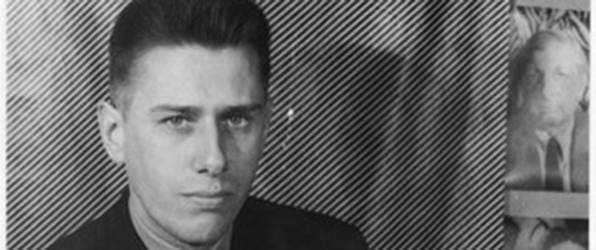
Throughout his life Cadmus maintained a tightly-knit circle of intimate friends and lovers, who together formed the artistic vanguards of the New York cultural scene. They collaborated and inspired each other, leaving behind a legacy of iconic artworks in multiple mediums. They also led the way in alternative lifestyles and relationships that queer theorists today would recognize as socially progressive and defiant against the heterosexual order of their time. In this photograph, Cadmus was captured by writer and photographer Carl Van Vechten, who was known for his homoerotic photographs and personal archive documenting queer life before Stonewall.
Important Art by Paul Cadmus
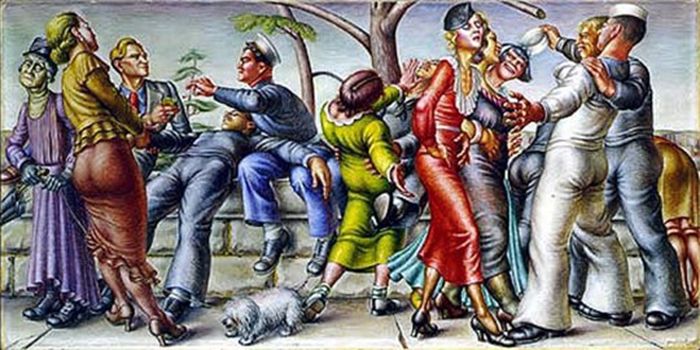
The Fleet's In!
The Fleet's In is the artist's most famous and controversial work. Cadmus painted it for the Public Works of Art Project (which later became part of the WPA). The PWAP provided a weekly income for artists painting American scenery for public buildings. Inspired by the sights at Riverside Drive in Manhattan, where sailors would dock, Cadmus decided to portray drunken sailors mingling with prostitutes.
The painting was selected for a 1934 exhibition at the Corcoran Art Gallery in Washington, DC. Prior to the opening, however, it was removed by Henry Latrobe Roosevelt, the Assistant Secretary of the Navy after retired Navy General Admiral Hugh Rodman had publicly denounced it. To Rodman, Cadmus's artwork directly insulted the Navy and its personnel. He described the painting as "a most disgraceful, sordid, disreputable, drunken brawl, wherein apparently a number of enlisted men are consorting with a party of street-walkers and denizens of the red-light district." The censorship of the painting gained national press coverage, and soon Cadmus was featured and quoted in newspapers across the country. The controversy ultimately benefited the young artist, serving as free publicity. He reflected: "So I was all on the front pages and that was the best piece of luck an artist could ever have had. Fortunately I was able to back it up later on with paintings that were not inferior, let's say."
It wasn't only the depiction of public drunkenness by sailors that led to the vehement response by the Navy, however. The painting's queer subtext might have played a role. Neither Cadmus himself nor the contemporaneous media ever explicitly addressed this theme. Art historian Jonathan Weinberg argued, however, that the coded meaning would've been clear to the Navy, even though general viewers might not have picked up on it. Queer art scholar Richard Meyer recognized in the blond-haired man with the red tie (3rd figure from left) a 1930s stereotype of a "fairy," an effeminate gay man. The red tie, furthermore, was a queer visual code signifying availability. In the painting, the masculine sailor eagerly accepts a cigarette offered by the "fairy," suggesting same-sex desire (The cigarette is possibly a play on the word "fag," a pejorative term for gay men which had been in use since the early 20th century). The depictions of bulbous body shapes under tight-fitting clothes, including the prominent bulge of the recumbent sailor next to the blond cigarette bearer, add further to the sexual atmosphere of the image. In this regard, the censorship and media attention possibly helped him attract queer viewers and supporters, especially. Seeing the work in reproduction, they would've immediately understood its subtext and found the work to be a daring expression of same-sex desire.
After its removal from the Corcoran Art Gallery in 1934, no public information about the painting's whereabouts was known until 1980 when it was discovered hanging at the Alibi Club, an exclusive all-men's club in Washington, DC. The painting was subsequently returned to the Navy. A year later, it was shown in public for the first time in 47 years in Cadmus's retrospective exhibition.
Tempera on canvas - Navy Art Collection, Naval History and Heritage Command, Washington, DC.
Coney Island
In this work, Cadmus painted a busy composition depicting beachgoers enjoying a sunny day at Coney Island, a popular destination for working-class New Yorkers. The loud and rowdy scene is filled with hairy, sweaty bodies clustered together while engaged in various activities: sunbathing, drinking, eating, reading, and playing sports on the beach. Cadmus incorporated figures that are not traditionally attractive. They have burnt and pimply skin, swollen bellies and double chins, grimacing faces with exaggerated features, long and gangly bodies with visible rib cages. While the figures exhibit crassness and vulgarity, the general atmosphere is joyous and carefree. Nevertheless, the artist also injected into the painting subtle references to the harsh realities of the time. For instance, Hitler's name can be seen on the headline of the newspaper on the belly of the bulky man napping in the foreground. The detail inserts a sobering dose of political reality that contrasts with the image's hedonistic atmosphere.
Cadmus's choice of subject was probably influenced by his friend, Reginald Marsh, who painted many compositions of Coney Island. Much like Marsh, Cadmus was inspired by the complex compositions of Old Masters paintings. Cadmus's Coney Island has a baroque quality: the bodies are twisted and appear to be in constant motion. In addition, the specific choice of Coney Island, with many figures showing skin, allowed Cadmus to explore his interest in the human body, also deriving from Renaissance art.
Art critics of the period recognized Cadmus as a satirist and compared his paintings to the works of English painter William Hogarth. Hogarth was an eighteenth-century caricaturist who used beauty as a signifier of virtue and manners, and ugliness and vulgarity as signifiers of moral depravity. Art historian Anthony Morris, however, makes an important distinction between Hogarth and Cadmus. He points out that the figures in Coney Island do not engage in any immoral or illegal activity. As a result, they are not subject to any repercussions (unlike in Hogarth's works), and there is no clear moral lesson to the painting. Instead, Morris ties Cadmus to the literary tradition of the carnivalesque, which, theorists have argued, challenged social standards and conventional hierarchies. Without espousing moral judgment, Morris offers an alternative reading of Cadmus's work: "The viewer is meant to find pleasure in the ability of Depression-era beachgoers to transcend the hardships of their daily lives... the unbridled joy they experience at Coney Island is a temporary respite from their workday lives." Indeed, as a sociological portrait, the painting provides a slice-of-life representation of everyday people in 1930s New York. Cadmus's figures deviate from the official visual culture of 1930s America that largely depicted traditionally attractive Anglo-Americans. They are, instead, more diverse, with different body types and Mediterranean, Eastern European and Western European features.
When Coney Island was first exhibited at the Whitney Museum of American Art's 1934 biennial, it was met with controversy. The museum received a complaint from the Coney Island Chamber of Commerce asking for the removal of the painting, citing its "vulgarity and physical grossness." Although the museum was threatened with a libel suit, it did not yield to the demands and the painting remained in the show.
Oil on canvas - Los Angeles County Museum of Art
Venus and Adonis
A fable from Ovid's Metamorphoses which also inspired one of Shakespeare's first publications, "Venus and Adonis" tells the story of how the Roman goddess Venus was accidently hit by Cupid's arrow and fell in love with the handsome hunter Adonis. Venus later saw in a dream that Adonis would be killed by a boar and tried to prevent him from going hunting. He did not listen to her. She later tragically found him dead, gored by a boar. Cadmus adapted the story with his biting sense of humor. He transformed Adonis into a handsome athlete, eager to join the boys for a tennis match (with his left hand holding two balls, suggesting a queer subtext). Venus, the goddess of Love, became a matronly society lady desperately clinging to him. To her right is Cupid, depicted as a chubby baby throwing a tantrum.
Cadmus based his composition loosely on Peter Paul Rubens's c.1930s rendition of the myth now in the Met's collection. Instead of Rubens's romantic-tragic portrayal, however, Cadmus's work may be read as a parody, a story of a gigolo bored by his middle-aged companion and the monotony of suburban heterosexual life.
Critic Henry McBride situated the subject more specifically. The picture, he wrote, "shows Frederick Perry, the tennis champion of Wimbledon, America and the rest of the world, abandoning the amateur ranks to become a professional. His wife and child protest vigorously but to no avail. Mr. Perry sells out to the money interests." Perry was a star tennis player and one of the 1930's most eligible bachelors, his romantic dalliances a subject of intense media coverage. He turned professional in late 1936, the year Cadmus painted this work.
Oil and tempera on pressed wood board - Private Collection
Sailors and Floosies
This is the final in a series of three paintings by Cadmus that dealt with the subject of the US Navy and on-leave sailors. Like The Fleet's In, the artist drew inspiration for this image from real-life scenes of cruising and debauchery at Riverside Drive. In the foreground, a handsome sailor has passed out while a "floosie" with thick makeup and a heavy build hovers over him. Next to his body we see a half-empty bottle of whisky and, above his head, a tattered newspaper showing an image of Mussolini boasting over his military successes with the ominous headline noting thousands of deaths from an air raid. Behind them are two other couples: on the left a sailor finds comfort in a woman's bosom, and on the right, a woman in blue seems to be protesting the advances of her date in a uniform. Aside from the couples, a lonely sailor occupies the bench in the far-right corner of the composition. Surrounding the painting, the unique frame Cadmus created for this work includes graffiti drawings that echo those on the architectural arch in the painting, which represents part of the Soldiers' and Sailor's Monument in Riverside Park. The frame functions as a decorative element, but also serves as an extension of the world and atmosphere presented in the painting.
The setting of the scene, with the wide, dramatic expanse of purplish-orange skylight, as well as the memorial with classical balustrades, serves as a nod to landscape painting in the Renaissance. Furthermore, the tight-fitting clothes of the figures allowed Cadmus to render in detail human anatomy and musculature, which he would've been familiar with from Old Masters paintings and drawings. And the pose of the sleeping sailor, recumbent with his arm above his head (along with his shaggy hair), recalls the Western art iconography of the sleeping faun, which traces back to the Barberini Faun sculpture from Hellenistic Greek culture. Cadmus's choice of the sleeping faun was apt. The original sculpture portrayed an exhausted yet erotically charged satyr who has passed out after drinking too much. (Satyrs are mythological half-human, half-beast creatures who often appear reveling alongside Dionysus, the God of wine and ecstasy. In art, satyrs are often a signifier of wildness and uninhibited sexuality.)
When first exhibited in 1940 at the Golden Gate Exposition held at Palace of Fine Art in San Francisco, Sailors and Floosies unsurprisingly became a source of controversy. Critics were outraged by the depiction of sailors as drunk and debauched figures, partying despite the global wartime situation (The US would formally enter the war the following year, after the bombing of Pearl Harbor). Cadmus rebuffed the criticism: "I think the picture portrays an enjoyable side of Navy life," he said, "I think it would make a good recruiting poster. I will raise my prices." The painting was temporarily removed in the interest of "national unity," but later rehung following the order of the general director of the Palace of Fine Arts, who stated: "If every picture to which some may object is removed, none would remain."
Oil and tempera on linen with wood frame - Whitney Museum of American Art
Herrin Massacre
When Life commissioned sixteen artists to paint significant events, Cadmus chose the Herrin Massacre, which took place in 1922 in the mining town of Herrin, Illinois. A contract dispute between striking miners and mine owners erupted into a violent riot, in which 23 men were killed, most of whom were workers hired by the mine owners to replace the striking union members.
In 1939, Cadmus visited the site of the massacre and noticed the Herrin cemetery (where some of the murders also took place) within the mine's vicinity. He set the scene of the painting there. As Lincoln Kirstein noted, this decision allowed Cadmus to insert Christian symbolisms into the composition: in the foreground a floral cross lies at the feet of the victims' bodies, while, to the right, the Lamb of God on a child's tomb is covered with the blood of the massacred. The foreshortened figures of the dead in the front may recall The Mourning over the Dead Christ (c.1475) by Andrea Mantegna, who used a dramatic foreshortened perspective to represent the dead Christ's body. These references to the crucifixion highlight the contrast between the naked, bloody bodies of the victims in the foreground, and the violent aggressors armed with guns, pipes, ropes, and pitchforks in the back. Life never published the work because of the controversial nature of the subject. The magazine was courting the support of organized labor and probably feared that the painting in which union members were the assailants would lead to a backlash from their readership.
Herrin Massacre was the last painting Cadmus painted using a mixed technique that combined oil and tempera. Encouraged by Jared French, in 1940 he switched to the early Italian method of painting with egg tempera. From then on it became his signature technique, and another way in which his art connected to the painters of the Renaissance. Contemporary reception of the work, including the 2019 exhibition "The Young and Evil" at David Zwirner Gallery, has framed the draw towards classical and Renaissance art among Cadmus and his circle as a demonstration of their queer artistic sensibility. Included in the show, Herring Massacre took on a homoerotic layer of meaning, owing to Cadmus's careful rendering of the male body. The wounded figures, one of whom near naked, recall another work by Mantegna, Saint Sebastian (1480), an iconic image of a martyred outcast that has been taken up by many queer artists as a symbol of ostracization by society.
Oil and tempera on wood panel - Columbus Museum of Art, Columbus, OH.
What I Believe
This painting is a tribute to the English writer E.M. Forster, a close friend who had a profound influence on Cadmus. The title of the painting is taken from Forster's 1938 essay, "What I Believe," in which the author defended democracy and humanist values in the wake of rising totalitarianism in Europe. The text deeply resonated with Cadmus.
The painting can be roughly divided into two sides: on the left is an idyllic paradise and, on the right, a scene of destruction. The muscular and sensuous figures that occupy the paradise at the foreground represent Cadmus himself, his family, and friends. The handsome artist is at the center of the composition, sketching. His close friend and former lover, Jared French, sits next to him, while Jared's wife, Margaret, stands behind them. Other members of this group include E.M. Forster standing next to Margaret, and, below her, George Tooker, the artist's lover at the time. He is reading a book whose cover reads "What I Believe." Behind the unidentified same-sex couple behind the main group, the artist's sister Fidelma and her husband Lincoln Kirstein spend a leisurely time, Fidelma resting her head on Kirstein's lap as he plays the flute, surrounded by animals. The construction behind them makes clear that this is a scene of creation and creativity. Cadmus and his circle become allegorical figures, personifying art, literature, music, and architecture.
In contrast, the right side embodies a destructive world threatened by totalitarian forces. At the very top, dictatorial figures resembling Hitler and Mussolini reign terror as missiles are launched from the dark skies. The masses, made up of all genders and races, are huddled together and indifferent to the military ravages around them. Death, in the right corner, takes the form of a gravedigger who covers his eyes from the horrors. At the center of the image, the lighthouse holds a special significance. Kirstein explained that it represents the historic lighthouse of Alexandria: "Forster described the world-famous Alexandrian beacon, a searchlight of classical civilization, which guided pilgrims and scholars into a port where culture flourished long after Athens and Rome had faded," he stated.
Jonathan D. Katz, a leading scholar of queer art, interpreted the division in the painting as a separation between the gay and the straight worlds. In his essay, Forster, a closeted gay man, had hinted at this divide, describing the keepers of culture as an elite group of "the sensitive" - a coded term for homosexuals. Cadmus's friends on the left side of the painting are artists and intellectuals, who represent the leading figures of the pre-Stonewall queer community. In contrast, the straight world is presented as a caricature, a community guided by ignorance and cruelty, plagued by death and destruction. According to Katz, Cadmus's vision suggests that Western culture can only be preserved by "the sensitive" community. The lighthouse of Alexandria, a phallic symbol, seems to offer hope as the future of culture itself hangs in the balance.
Tempera on panel - McNay Art Museum, San Antonio, TX
Night in Bologna
Longing and sexual desire form the subject of this painting, a tragicomic "lust triangle" of sorts set in the evening hours amidst the arcade arches and columns typical of classical Italian architecture. In the foreground, a lonely Italian soldier looks towards a shapely woman in a tight dress. He wears tight-fitting uniform pants and is standing, his straight body aligned with the phallic tower in the back. The woman, unaware of the soldier's gaze, has set her sights on a lonely American tourist sitting at a far table. However, the suit-clad tourist, sitting meekly with his legs crossed, is obviously checking out the soldier. Cadmus used colors that represent three of the seven deadly sins to illuminate each of the characters: red for lust (the soldier), yellow for greed (the woman), and green for envy (the tourist).
During the 1950s, Cadmus spent a lot of time in Europe, especially Italy. The painting expressed the artist's love for Bologna, which is famous for its architecture. However, Cadmus stated that he was not inspired by a specific location. Instead, he used different photographs of the city to help him invent a backdrop. Among his works, this painting, the artist mentioned on several occasions, was his favorite: "It's partly because it's unlike my other pictures. It's because it's a quiet picture and most of my pictures are really rather noisy pictures full of movement." Indeed, the relatively sparse composition and dramatic lighting are uncharacteristically reminiscent of works by painters such as Edward Hopper, another key artist in the American Realism tradition.
Egg tempera on fiberboard - Smithsonian American Art Museum, Washington, DC.
Biography of Paul Cadmus
Childhood
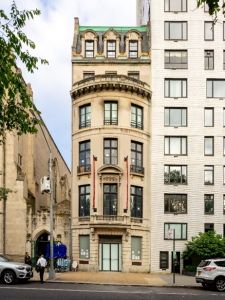
Paul Cadmus was born in 1904 in New York City to a father of Dutch ancestry and a mother with a multicultural lineage - her family was originally from the Basque region in Spain, before immigrating to Cuba and finally settling in the United States. Two years after Paul's birth, his sister Fidelma was born. Despite their poverty, the children grew up in an artistic and creative environment, encouraged by their father Egbert, a commercial lithographer and watercolorist, and their mother Maria, a children's books illustrator (they'd met in art school).
Given his parents' support, Cadmus was sure of his career path from a very early age. In 1919, he left public school to join the National Academy of Design, where he stood out as one of the most talented students and received several awards. During his six years at the Academy, Cadmus received a comprehensive artistic education, including life drawing, printmaking, and etching, all skills that he would later utilize as an artist.
Early Training and Work
In 1928, Cadmus began working as a layout artist at a New York advertising agency, while continuing to take classes at the Art Students League. There, he met painter Jared French, a fellow student with whom he had a romantic relationship that became a lifelong friendship as well. French played a key role in Cadmus's artistic development and was a major influence on the artist throughout his career. In fact, French was the one who persuaded Cadmus to abandon his commercial work in order to pursue a career in fine arts. In 1931 the couple left for Europe on an oil tanker in hopes of finding a more stimulating environment for their work. The two artists settled in Mallorca, where Cadmus officially began his painting career. Although he painted some subjects from the Mediterranean island, most of his time was dedicated to American themes, including two major works: Shore Leave (1933) and Y.M.C.A Locker Room (1933). Over a period of two years, Cadmus and French toured France and Spain and later visited major museums and art sites in Germany, Italy and Austria. There, Cadmus saw the works of Renaissance artists such as Andrea Mantegna and Luca Signorelli that would inspire him throughout his career.
While in Europe, Cadmus received press clippings from his sister Fidelma about the Public Works of Art Project. By late 1933, the men were running low on money and decided to return to New York. He and French both applied to the WPA and continued working side by side in their studio on St. Luke's Place. Cadmus was accepted to the WPA in December, for which he produced the paintings The Fleet's In (1934) and Greenwich Village Cafeteria (1934).
The Fleet's In was selected for a WPA show at the Whitney Museum, before travelling to another exhibition at the Corcoran Art Gallery in Washington, DC. I t became a subject of controversy and was removed from the exhibition as the subject matter, drunken sailors on leave mixing with prostitutes, had offended the Navy. Because the painting had already been photographed, however, its reproduction was reprinted by the press, allowing Cadmus to capitalize on the media attention. By the mid-1930s, he had established himself as an up-and-coming young artist. Partly due to the controversy, his first solo show, held at Midtown Galleries in 1937, attracted a crowd of more than 7,000 viewers.
The year 1937 was also personally significant for Cadmus. His relationship with French changed after the latter had married Margaret Hoening, an artist they both had known from the Art Students League. However, Cadmus did not seem to hold any animosity towards Jared or Margaret. The three became inseparable, and Cadmus continued to share the studio on St. Luke Place's with French. In that same year, Cadmus also met Lincoln Kirstein. A philanthropist, writer, and art patron, Kirstein was an influential cultural figure in New York, best known for co-founding the New York City Ballet. Kirstein would not only become part of Cadmus's inner circle but also one of his biggest champions and patrons. In 1941, he became Cadmus's brother-in-law when he married his sister Fidelma.
Mature Period
The 1940s brought several changes to Cadmus's work. At the urging of Jared French, Cadmus switched to painting in egg tempera. The medium appealed to Cadmus as it had been used by the Renaissance masters he deeply admired: "When I found that medium, I loved it so much I didn't really want to use anything else," he said.
While his early paintings had been characterized as social satires, the new decade saw an expansion of his repertoire. This new cycle of paintings was inspired by the summers he spent on Fire Island with Margaret and Jared French. These smaller format works included delicate portraits, images of dancers, and beach scenes. Many of them became associated with Magic Realism, a term that was popularized in 1943 by the seminal exhibition "American Realists and Magic Realists" at the Museum of Modern Art in New York. Curated by Dorothy C. Miller with the assistance of Alfred H. Barr Jr.. and Lincoln Kirstein, it featured 16 paintings by Cadmus. Seen as a continuation of the American Realist tradition, Magic Realism emphasized the mysteriousness and uncanniness of everyday reality. Kirstein explained the unique nature of Magic Realism: "By a combination of crisp hard edges, tightly indicated forms, and counterfeiting of material surfaces such as paper, grain of wood, flesh or leaf, our eyes are deceived into believing in the reality of what is rendered, whether factual or imaginary." In Cadmus's case, many of these intimate scenes subtly expressed homoerotic elements, using a codified language to suggest same-sex desire.
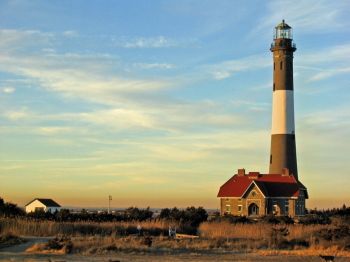
The summers spent on Fire Island led to further artistic experimentation for Cadmus. Along with Margaret and Jared French, Cadmus shot staged photographs of sensuous nudes with Margaret's Leica camera. The trio formed a photography collective known as PaJaMa, combining the first two letters of each of their names (Paul, Jared, Margaret). In 1944, he met George Tooker, a recently discharged Marine and painter who had resumed his studies at the Art Students League. Cadmus took Tooker under his wings and, along with French, taught him their method of using tempera. Soon, Cadmus and Tooker became lovers, and the younger artist rented a studio near the one Cadmus shared with French. Tooker became a fixture on Fire Island, posing for many of Cadmus's paintings and the PaJaMa photographs. Recognizing the common painterly affinity between Cadmus, French, and Tooker, art historian and curator A. Hyatt Mayor even referred to them as "the Fire Island School of Painting."
During the same period, Cadmus developed a keen interest in the writings of English novelist E.M. Forster. Their friendship began through correspondence, and the two met for the first time in 1947 when Forster visited New York. Cadmus cherished his friendship with Forster, expressing his admiration for the writer in the painting What I Believe (1947) - an homage to Forster's essay of the same title.
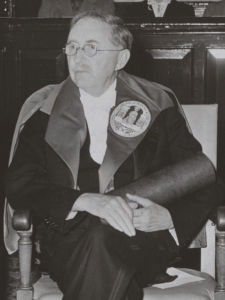
In 1949 Cadmus and Tooker, along with the Frenches, travelled to Europe. Cadmus and Tucker's relationship came to an end there. According to Cadmus biographer David Leddick, Jared was a source of tension between them and ultimately led to them parting ways. Leddick's account quotes Cadmus: "George wanted me all to himself, but that was not possible. I was not going to give up Jerry [Jared] in any case." After his split with Tooker, Cadmus maintained his close relationship with the Frenches. He divided his time between France and Italy from 1951-1953 before returning to New York, to the St. Luke's studio that he had shared with French. For most of the 1950s, Cadmus was surrounded by his close circle of friends. He spent the summers on Fire Island and visited Europe frequently.
Late Period
Around 1960, the Frenches decided to move to Europe permanently and sell the studio on St. Luke's Place. Subsequently, Cadmus moved to a studio on Remsen Street in Brooklyn Heights. In 1964, he was visiting Nantucket when he met Jon Anderson, a former cabaret star. The two began a relationship, and Anderson became Cadmus's principal model and muse. Most notably, Cadmus used Anderson for a series of male nude drawings that he worked on during the later phase of his career. He spent the latter part of his life living with Anderson in Weston, Connecticut in a studio that Kirstein had built for him. Cadmus and Anderson remained together for thirty-six years, until Cadmus passed away on December 12, 1999, at the age of 94, only five days before his ninety-fifth birthday.
The Legacy of Paul Cadmus
Paul Cadmus was one of the most controversial artists of the 1930s. His biting social satires challenged traditional morality, often prompting outrage and even censorship. Cadmus, with his uncompromising attitude, was able to capitalize on the media attention and establish himself as one of the leading artists of his time. His homoerotic iconography, as art historian Jonathan Weinberg pointed out, was coded and would've been understood among a knowing group of viewers, allowing a shared sense of enjoyment that operated under the radar of traditional culture. With the rise of Abstract Expressionism in the late 1940s, Cadmus and other figurative painters faded into obscurity. Despite changing trends, Cadmus remained true to himself, continuing to channel Old Masters in his technique, intricate compositions, and delicate treatment of the human body.
The post-Stonewall era led to a renewed interest in Cadmus's art. Media outlets and scholarship started to examine his works through the lens of sexuality and celebrated the gay artist as a role model and a major influence on Queer Art. For Cadmus, this newfound interest was met with some ambivalence. While he never hid his homosexuality, he rejected the concept of identity politics, stating that "gayness is not the raison d'être of my work." As art historian Philip Eliasoph explained, Cadmus's attitude can be attributed to a generational divide: "He pleaded to those engaged on the frontlines of militant gender politics [circa 1970s-1980s] to respect that he was from a generation for which reticence and discretion signaled an unspoken ethical code." Instead of addressing the homoeroticism in his works, Cadmus preferred talking more about his interest in the nude and the influence of Renaissance painting on his works. Scholar Richard Meyer, who wrote extensively about queer elements in Cadmus's art, offered a nuanced explanation: for someone from Cadmus's generation, "homosexuality [...] cannot be understood within the coherent, confident terms of what we now call gay identity." From today's queer theoretical vantage point, his draw toward the Italian Renaissance, his satirical view of American life, and his depictions of homoerotic and sensuous male bodies altogether form a queer sensibility outside of a specific identity or political message. It is instead an early iteration of a queer aesthetic.
Influences and Connections

-
![George Tooker]() George Tooker
George Tooker - Jared French
- Margaret French
- Lincoln Kirstein
- E.M. Forster
-
![George Tooker]() George Tooker
George Tooker - John Burton Harter
- Jared French
- William R. Christopher
- George Platt Lynes
- PaJaMa Group
Useful Resources on Paul Cadmus
- Paul Cadmus (1992)Our PickBy Lincoln Kirstein
- Intimate Companions - A Triography of George Platt Lynes, Paul Cadmus, Lincoln Kirstein, and Their Circle (2020)By David Leddick
- Cadmus, French and Tooker, The Early Years (1990)By Josephine Gear
- Paul Cadmus: The Sailor Trilogy (1996)Our PickBy Richard Meyer, Adam D. Weinberg
- American Realists and Magic Realists (1943)By Dorothy C. Miller, Alfred H. Barr, Lincoln Kirstein
- Hide/Seek: Difference and Desire in American Portraiture (2010)Our PickBy Jonathan D. Katz and David C. Ward
- The Young and Evil: Queer Modernism in New York, 1930-1955 (2020)By Jarrett Earnest et al.
 Ask The Art Story AI
Ask The Art Story AI





















